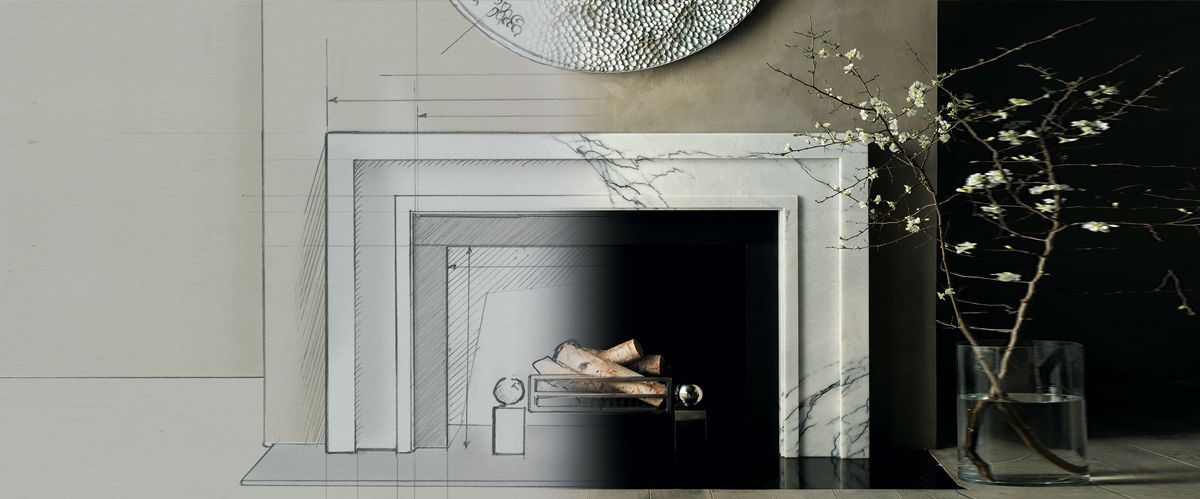14.06.2017

The installation of any fireplace is a big job and we would always recommend using the services of a experienced fitter who is familiar with fitting the kind of fireplace you have purchased. Whilst the installation of the fireplace itself is mostly general building work, gas fires must be fitted by a Gas Safe registered engineer to ensure that the fire is fitted safely. Any gas fire that has not been fitted by a Gas Safe installer could seriously cause a risk to your health and also invalidate any guarantee the fire has.
The information below will explain the basic stages of fitting a standard ´hearth mounted fireplace´ which would consist of a wooden fire surround, marble back panel & hearth and a inset living flame gas fire. For our guide, we will imagine that the fireplace is being fitted into an existing Class 1 chimney breast. The guide is not designed to be used as step-by-step instructions but aims to offer an insight into a job that most customers are usually surprised to find out how complicated it actually is.
Once you have found your perfect new fireplace, it is always worth having a survey carried out by a qualified fireplace fitter. This will determine whether your chosen fireplace will indeed fit into your chimney or flue and also give you an idea on the installation costs involved and any extras you may need. Most dedicated fireplace installers will be able to carry out all aspects of the fit including sweeping the chimney if needed, fitting a chimney cowl and plaster work around the fireplace.
As part of any Gas Safe registered fireplace fitters procedures, they should first check the chimney/flue to make sure that there is no leaks - this is done by a smoke test. If it is determined that the chimney is leaking and it can´t be rectified, a flue liner will need to be fitted. This then bypasses the masonry chimney all all fumes are expelled through the liner.
Next step is normally checking to see if you have the correct chimney pot/cowl for your fire. A open chimney pot is usually fine for living flame gas fires but it does leave the chimney open to the elements. We would always recommend having a cowl fitted to any open pot. This will prevent anything entering the chimney and also reduce any down-draft.
Once the fitter has confirmed that your flue is suitable and quoted for the installation, it is now time to purchase your new fireplace (Never book your fitting date until you have received your fireplace and it´s been fully inspected) Once all preparation work has been carried out, the next step in fitting this type of fireplace is bedding the hearth down. As the rest of the fireplace sits on the hearth, it is extremely important that the hearth is completely level and supported underneath. Most installers use a dry mix of bonding plaster. They mark out the correct position of the hearth then put approximately 8 ´blobs´ of the mix on the floor, the hearth is then placed on top on using a spirit level it is gently levelled both left to right & front to back.
Once the hearth has been laid and the plaster mix has set, the back panel can be placed roughly in place on top of the hearth (A common mistake at this stage is that often a fitter who is not competent at fitting fireplaces will stick the back panel to the wall) The back panel can be leaned up against the wall at this stage as it is in fact the fire surround that is the next part to be fixed. Lift the fire surround on top of the hearth and centre it so it sits evenly on the hearth. The back panel should still be loose, leaning up behind the legs of the mantel. Fix the fire surround to the wall - normally done by brackets on the outside legs of the mantel.
The back panel now gets centred behind the fire surround and it needs to be pulled forward to meet the inside legs of the fire surround (Rebate) Once in position, the remainder of the plaster mix us used to fill any gaps around the fireplace opening and the chimney opening to ensure none of the gas fire fumes can get behind the fireplace.
Finally, the fitter will fit the gas fire into the back panel opening. Once fitted, they should perform a final set of checks including making sure that the gas fire fumes are not spilling into the room. You should make sure that your fitter fills in the installers section on guarantee card for your fire as this is used as proof that the fire has being professionally installed in case you need to make any warranty claims.
To see the full selection of fireplaces HotPrice can offer - click fireplaces